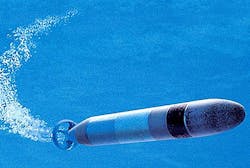Navy orders underwater drones that can mimic the behavior of quiet enemy diesel submarines
Officials of the Naval Undersea Warfare Center (NUWC) in Newport, R.I., announced a $49.5 million contract to Lockheed Martin Sippican on Thursday to build 39 unmanned underwater vehicles (UUVs) able to emulate the behavior and sensor signatures of enemy submarines to help Navy ASW experts practice their skills from surface warships, submarines, helicopters, and fixed-wing aircraft.
These Sippican UUVs that can disguise themselves as potentially hostile submarines are called the MK 39 Mod 2 expendable mobile antisubmarine warfare (ASW) training targets (EMATT).
These next-generation ASW training targets are designed to help Navy submarine-, surface ship-, and aircraft-based ASW forces train to detect, hunt, and destroy quiet enemy submarines.
Navy aircraft and surface warship crews will use the second-generation EMATT to train in open-ocean, unrestricted, and on-range ASW training missions. The Navy can launch EMATT out of sonobuoy launchers on ASW helicopters and fixed-wing aircraft, and from moving surface warships.
The EMATT is 3 feet long, 5 inches in diameter, and weighs 22 pounds, so it is small enough to be dropped into the ocean by hand from ships or helicopters.
The submarine-emulating UUV has sensors that emulate acoustic and non-acoustic signatures of advanced nuclear- and diesel-powered submarines, and can operate for as long as eight hours on one battery charge. Sippican also offers a version of EMATT that can be launched from submarines called the Submarine Mobile Acoustic Training Target (SUBMATT).
story continues below
Control software for the Sippican EMATT runs on a Windows PC or laptop computer, and can program the target's course, depth, speed, time, and passive tonal changes. The software also can program the EMATT to maneuver automatically in response to active sonar pings.
Lockheed Martin engineers are designing the latest version of EMATT to be more affordable than previous generations of ASW training targets. The latest version has programmable acoustics, better representation of hostile submarines than previous versions, and acoustic communications links that Navy forces can use in daytime, at night, and in rough seas, company officials say.
Lockheed Martin Sippican will do the work on Thursday's contract in Marion, Mass., and should be finished by March 2021. For more information contact Lockheed Martin Sippican online at www.sippican.com, or the Naval Undersea Warfare Center-Newport at www.navsea.navy.mil/Home/WarfareCenters/NUWCNewport.
